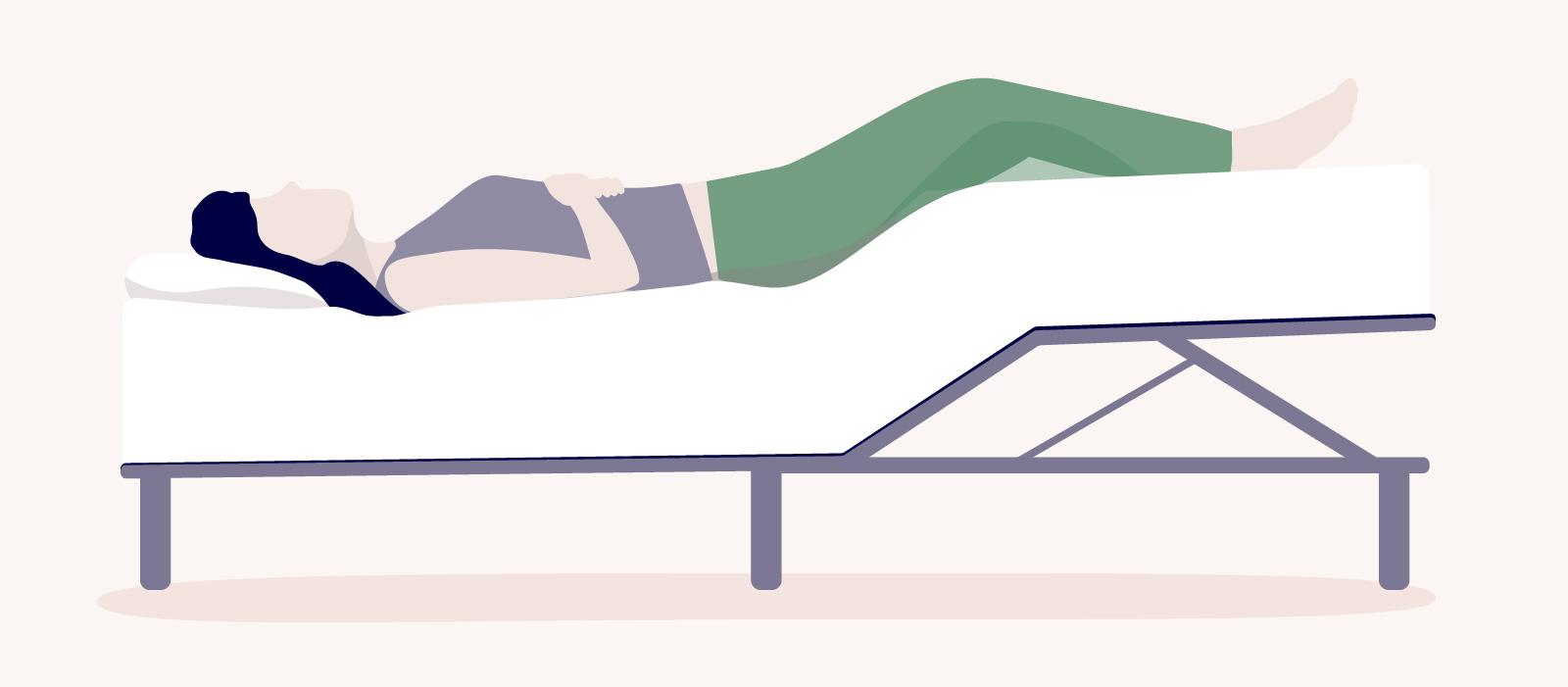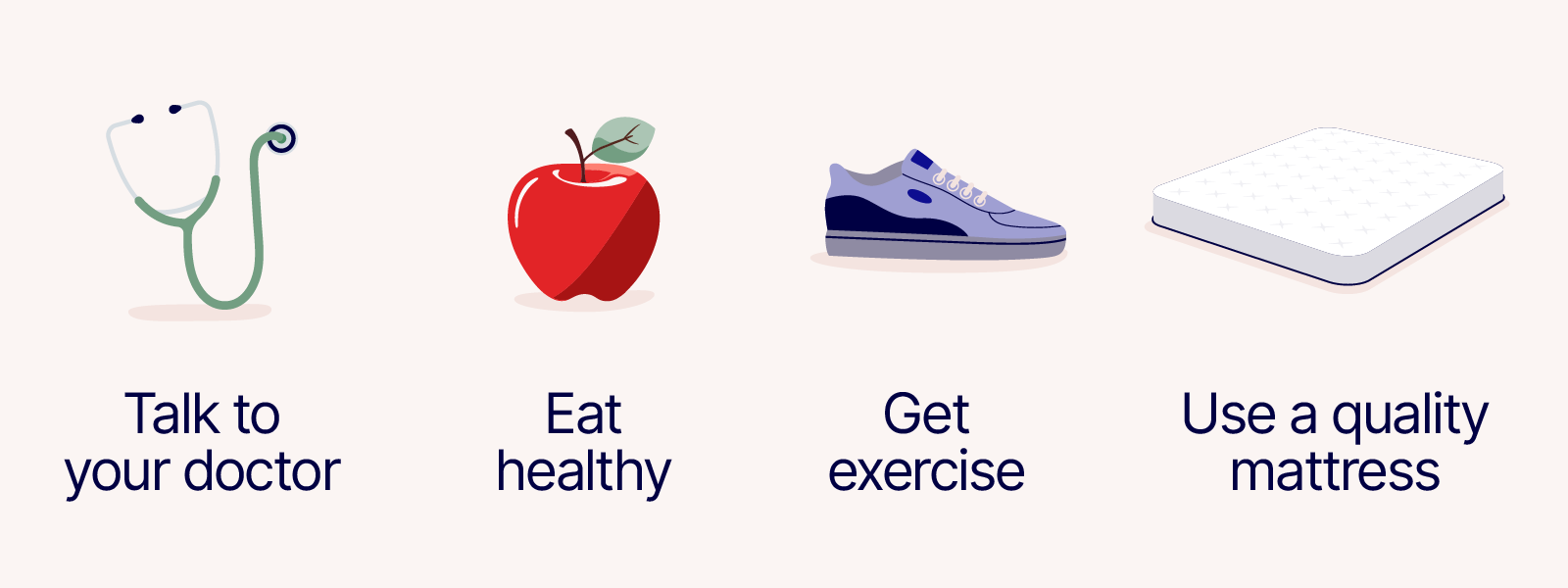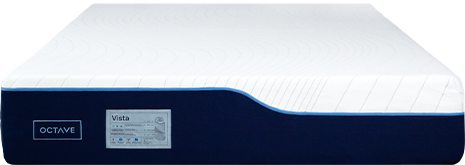Best Sleeping Position For Peripheral Artery Disease (2025)
Updated: June 16, 2025 | Published: May 9, 2024Peripheral artery disease (PAD) affects your body’s blood vessels and causes pain and fatigue in your leg muscles. It occurs when an artery, usually in your leg, has a buildup of arterial plaque (atherosclerosis). PAD is a serious condition as it raises your risk of heart attack and stroke (Lavallée et al., 2003).
PAD is fairly common. According to the Canadian Foundation for Vascular Health, almost 3 million people aged 50–79 were living with PAD in 2015. But getting a good night’s sleep with PAD isn’t always as common. In this article, we’ll show you the best sleeping position for peripheral artery disease and how to relieve symptoms while you sleep.
We co-authored this article with Dr. James Keung, a dedicated healthcare provider with expertise in chiropractic care and massage therapy. The following tips, including those from Dr. Keung, are general recommendations and aren’t meant to replace your doctor’s professional diagnosis. Always consult your physician before trying these sleep positions at home.
Position 1: Elevate Your Legs

Sleeping with your legs elevated is one way to improve circulation in your feet while sleeping and relieve your PAD symptoms.
This position prevents blood from pooling in your legs, particularly in areas where arterial plaque is affecting blood flow, and reduces pressure caused by blood buildup. It also reduces the strain on your heart when it’s pumping blood to your feet.
It’s important to keep your legs consistently elevated while you rest. Using a stack of blankets or pillows isn’t effective since your body shifts position during your unconscious hours.
Instead, consider investing in a bed with an adjustable base, like the Octave Adjustable Bed. Adjustable beds let you control the elevation of specific areas of your mattress. This makes it easy to customize your bed’s elevation to your comfort level—and maintain that elevation all night long.
| Dr. Keung’s Tip: |
|---|
Sleeping on your back with the legs elevated may also help to increase circulation to the heart, as this can prevent blood from pooling in your feet (Marygrace, 2024). |
2. Lie On Your Back

Sleeping flat on your back distributes your body’s weight evenly across your mattress. This reduces the strain on your circulatory system, including parts of your body affected by PAD. It can be a good sleeping position for cramps and other pains.
However, this position isn’t recommended if you snore at night. You also shouldn’t sleep on your back if you’ve been diagnosed with a sleep-related breathing disorder like sleep apnea.
Sleeping on your back can also be difficult if you have a mattress that doesn’t meet your specific needs. Make sure you have the right type of mattress to support back sleeping. The best mattress for back sleepers is one with a medium-firm feel. In our experience, medium-firm mattresses hit that sweet spot of cushioning and support.
Studies have also shown that medium-firm feel mattresses help improve sleep quality and reduce the risk of developing lower back pain (Caggiari et al., 2021).
READ MORE: Best sleeping positions for lower back pain
If you find that back sleeping makes it hard to get up in the morning, a mattress with an adjustable base is helpful here, too. Check out our list of the best adjustable beds in Canada, with independent head and foot controls that make it easy to hop out of bed.
| Dr. Keung’s Tip: |
|---|
Over 50% of people with PAD may also have Obstructive Sleep Apnea (Szymański et al., 2019). If you suspect you may be suffering from OSA, speak to your doctor right away. |
3. Sleep On Your Side

Sleeping on your side can keep your legs comfortable and make it easier to breathe.
You’ll give your circulatory system the most relief by reducing the amount of strain on your body. Keep your shoulders and hips “stacked” over each other. Avoid tucking your legs close to your body and bend them as little as possible to maintain good circulation (Akinwande, 2023).
READ MORE: Best Sleeping Position for IT Band Pain
If you find it hard to sleep on your side, consider switching to a mattress tailored to that specific sleep style. Octave Vista‘s full-body support, exceptional motion isolation, and pressure-point relief make it one of our best mattresses for side sleepers.
| Dr. Keung’s Tip: |
|---|
Putting a pillow between the knees will make it easier to stay in a side-lying position. It can also help your body stay in better alignment and reduce strain on your hips. |
Frequently Asked Questions
What is peripheral artery disease (PAD)?
Peripheral artery disease occurs when plaque builds up in your arteries, causing them to narrow and harden. This restricts the flow of blood in a specific region of your body. As a result, the cells in that area don’t get enough oxygen.
PAD most often occurs in the legs, but it can sometimes show up elsewhere in your body. Symptoms include:
- Leg pain
- Muscle cramps
- Early-onset muscle fatigue after active movement
- Intermittent pain or discomfort when resting
- Skin that is noticeably cooler to the touch around the affected area
However, many people with PAD have no symptoms at all. If left untreated, PAD can lead to severe complications like skin ulcers. Talk to your physician if you have these symptoms, or if there are other reasons to think you might have PAD.
Why is good sleep important for PAD patients?
Good sleep is tied directly to your vascular health. According to the European Heart Journal, people are at higher risk for arterial disease if they get poor-quality sleep, or sleep less than five hours a night.
They’re also at a higher risk of high blood pressure and other heart-related conditions, which can worsen existing PAD symptoms.
Getting the right kind of sleep will do more than just help you manage your PAD. It’ll help you to be healthier overall, and can help to manage other forms of ongoing body pain such as sciatica.
What sleeping positions should PAD patients avoid?
Avoid sleeping on your stomach if you have peripheral artery disease. Sleeping in this position often obstructs your breathing and distributes your body’s weight unequally. This can cause blood to flow toward your legs, and make pain or other symptoms more difficult to deal with.
If you sleep on your side, avoid bending your legs or tucking them toward your body in the fetal position. This can restrict blood flow between your heart and lower body (Akinwande, 2023).
What are some sleep tips for heart patients with PAD?
Set yourself up for a good night’s sleep by following a bedtime routine. This routine could include taking a hot shower, reading a book, and going to bed at the same time every night.
It’s also a good idea to avoid eating large meals or drinking alcohol right before bed. Avoid caffeine and screen time in the hours leading up to bedtime, too.
In addition to these general ideas, you can try the following more specific tips to relieve your nighttime PAD symptoms and get a more restful sleep.

Speak with your physician
If your PAD keeps you up at night, talk to your doctor about ways to sleep better. For example, some heart medications can make you drowsy or keep you awake. If your doctor agrees it’s safe, changing the time that you take your medication may help you fall asleep more easily.
Choose nutritious foods
Meals and snacks with lots of nutrients will help keep your body in good condition and may relieve your PAD symptoms, both at night and during the day. Avoiding caffeine after 5pm and reducing alcohol consumption may help you sleep better, too.
Exercise regularly
Regular exercise—especially cardio—can help improve your PAD symptoms. Even just 15 minutes of walking can help get your blood moving. Exercise also tires you out, making it easier to fall asleep when you finally go to bed.
Choose a supportive, good-quality mattress
The best type of mattress for peripheral artery disease can vary from person to person. However, foam and hybrid mattresses are popular choices because they can contour around your body and provide targeted support.
We recommend trying Octave. This memory foam mattress features ergonomic zoned support and provides targeted pressure-point relief. It also has a medium-firm feel that’s ideal for all sleep positions.
READ MORE: Check out our ranked list of the best mattresses for scoliosis
Peripheral artery disease (PAD) affects millions of Canadians. But when you choose the right sleeping position, the right habits, and the right mattress, you can make it easier to live with your PAD—and get a good night’s sleep.
Our goal is to provide the information you need to find the mattress that’s right for you. Get started with some of our most popular mattress shopping resources:
- Best Mattress Guides: Best Mattress Canada, Best Mattress In a Box
- Reviews: Douglas Original, Logan & Cove Choice, Juno, Octave Vista
- Comparisons: Douglas vs Endy, Douglas vs Casper
We use independent, third-party engineering firms (commissioned by us) with the APEGA stamp of approval to conduct mattress testing on our behalf, using publicly available data. We review and test all mattresses on 40+ criteria we think are important to you, including price, country of manufacture, sleep trial, warranty, features, materials used, motion isolation and edge support ratings, customer satisfaction reviews, returns, and refunds.
References:
- Caroline Lavallée, Vincent Daignault, Louise Boivin, Cendrine Mathews, Linda Vardy, Hannah Wilansky, Hasnain Mawji, et al. Living Well With Heart Disease: A Guide for People With Coronary Artery Disease, 2003.
- Taylor, Marygrace. “Doctors Reveal the Best Sleeping Position to Outsmart Peripheral Artery Disease Leg Pain.” Yahoo!, January 19, 2024. https://www.yahoo.com/lifestyle/doctors-reveal-best-sleeping-position-152729438.html.
- Gianfilippo Caggiari et al., “What Type of Mattress Should Be Chosen to Avoid Back Pain and Improve Sleep Quality? Review of the Literature,” Journal of Orthopaedics and Traumatology 22, no. 1 (December 1, 2021), https://doi.org/10.1186/s10195-021-00616-5.
- Szymański, Filip M., Dariusz Górko, Anna E. Płatek, Tomasz Ostrowski, Krzysztof Celejewski, Witold Chudziński, Anna Hrynkiewicz−Szymańska, et al. “Prevalence of Obstructive Sleep Apnea in Patients With Peripheral Arterial Diseases.” Sleep & Breathing 24, no. 3 (November 14, 2019): 1035–41. https://doi.org/10.1007/s11325-019-01950-z.
- Goke Akinwande, MD. “Best Sleeping Position for Peripheral Artery Disease – What You Need to Know: Midwest Institute for Non-Surgical Therapy: Vascular and Interventional Radiologists,” n.d. (May 19, 2023), https://www.mintstl.com/blog/best-sleeping-position-for-peripheral-artery-disease-what-you-need-to-know#:~:text=If%20laying%20on%20your%20back,this%20can%20restrict%20blood%20flow.



